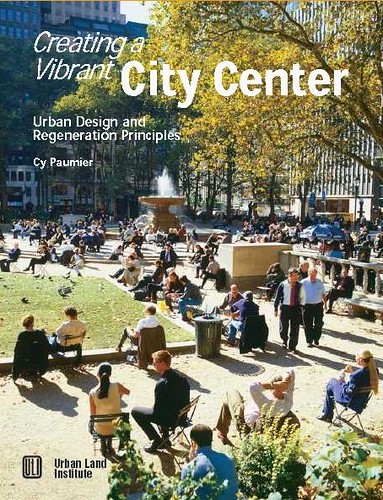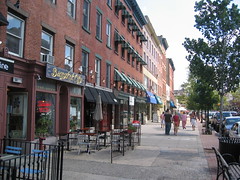Professionals vs. amateurs in the building "arts"
My gf and I sometimes disagree on assessments of new buildings. Buildings I think are okay, she thinks aren't all that great. In part it's because I have been beaten down by so many bad buildings, that a marginally better building ends up shining like a beacon by comparison.
Iit all comes down to a couple old lines: "better than cinder block shouldn't be the standard that we aspire to" and "anything isn't better than a parking lot" vs. "if you ask for nothing, that's what you get; if you ask for the world, you don't get it but you get a lot more than nothing."
Too often, the standard in revitalizing places is "well, it's better than the empty (or parking) lot."
Most of the time it isn't. It's better to wait and work for something better.
One of the "problems" in the built environment is that even "short run" decisions about temporary buildings yield buildings that last from 15 to 50 years. Those are decisions that don't change any time soon.
Sitting in at a recent Zoning Commission hearing proves the criticisms I made about the DC Comprehensive Plan back in 2006, during the approval process. One of the points I made is that the elements should be ordered, that land use, transportation, and urban design be considered the foundational elements. When all the elements are equal, everything but land use is secondary.
In short, I think that urban design is perhaps the most important element of a city's comprehensive plan, that urban design needs to dictate what is built, where and how on the lot, and that it must connect to the place beyond the lot lines of the specific project.
There are many resources on urban design that I recommend including:
-- Urban Design Compendium (online)
-- Close Encounters with Buildings (Jan Gehl) (online);
-- the DC Urban Design Element of the DC Comprehensive Plan reads very well, is illustrated and lays out the principles (even if no one reads or applies this element to land use decisionmaking and policy in the city...); and
-- Creating a Vibrant City Center, by Cy Paumier. The book is published by the Urban Land Institute, which by the way, has a blog, The Ground Floor. (ULI has an impressive publishing program producing great books and reports, and has a consulting operation, called Advisory Service Panels, both for profit and nonprofit, that provides assessment and improvement reports for tough projects. (If you read these kinds of reports you learn a lot and can find much to think about in terms of your own situation.)

And there are (at least) two very good resources that citizens can use to help evaluate projects, with the end objective of making them better:
-- Urban Design Evaluation guidelines from Philadelphia's Design Advocacy Group;
-- Commercial Design Assessment evaluation form from the Community Design Assessment: A Citizens' Planning Guide published by the National Trust for Historic Preservation

Of course, if your community's regulations don't "have your back," only enlightened developers will be responsive, and you won't get much improvement.
This really matters in the mixed use environment, because buildings with housing are likely to "never" be replaced within our lifetimes, especially if the buildings include condominium housing.
Typically, office buildings can be "refaced" with an updated facade to help the building stay marketable. But no condominium owner is going to agree to a supplemental assessment to pay for an updated facade because the building looks like a dog, because they likely wouldn't see that come back in higher property values. So "what you see is what you get." Forever.
In "City Approves New Strip Mall," the Fairfax Times reports how the City of Fairfax is allowing a typical strip shopping center, albeit with some brick and stone, to be built on a key parcel, currently open space.
Given that most communities have fewer opportunities for breakthrough development, opportunities can't be squandered, and the best urban design, achieving multiple objectives, such as creating a walkable environment rather than strengthening the automobile-centric environment, should be emphasized, especially given the massive increases in the price of gasoline, prices which aren't likely to go down very much, prices that are inducing significant behavior change for many in terms of decisions about tasks, where to live, where to work, and how to get there.
Sadly a Fairfax City Councilmember, just like I do sometimes, is overly enamored of brick and stone, and not paying enough attention to urban design, according to this paragraph from the article:
Councilman Scott Silverthorne expressed his regard of the developer, John Donegan. Donegan's developments are not "just strip malls. They're works of art," Silverthorne said.
Here is some of the art produced by the developer.
![MSM1[1].jpg](http://farm4.static.flickr.com/3211/2611046571_b44a65e407_m.jpg)
![Dscn2832[1].jpg](http://farm4.static.flickr.com/3142/2611879264_587bc75a3b_m.jpg)
But a strip shopping center, even gussied up in brick and stone and using public market buildings as models for a supermarket, is still a parking fronted one or two story strip shopping center that people drive to, a center that is empty and forlorn during all the hours in which it is closed, and an underutilized piece of property that could, if properly developed, have multiple stories with office and residential uses as well.
I'd rather have something like this.

Washington Avenue, Hoboken, New Jersey. Photo by Steve Pinkus.
But if you don't make urban design pre-eminent in your Comprehensive Plan, it doesn't matter how well written the element is. DC's Urban Design Element is great. But I doubt if anyone on the Zoning Commission has ever read it.
Labels: urban design/placemaking



0 Comments:
Post a Comment
<< Home